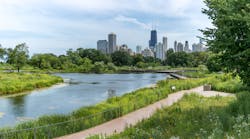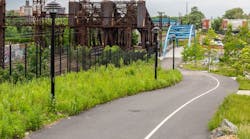A few weeks ago, a friend and I were taking a walk around Chicago's Lincoln Park when we came to the North Pond Sanctuary, which was partially under construction. At first glance, I knew there was some kind of restoration work being done. Upon further inspection, we found a sign that explained there was native wetland
planting in progress. This restoration is part of a larger project, the Sunshine Playscape, and in this section, the work is aimed at filtering stormwater before it enters the pond. My friend, someone who is not familiar with the
stormwater industry, peppered me with questions. Her curiosity was encouraging, even if it was partly just her being a good friend and playing along with my excitement.
I often hear from industry professionals that a common roadblock is communication with the public. “Out of sight, out of mind,” is a phrase I hear all too often regarding stormwater. At the end of the day, it isn’t always out of sight, and my walk around Lincoln Park is the perfect example. When projects are visible to the public,
curiosity is born. Communicating, even if it is through signs, takes extra time that oftentimes isn’t available, but when it does happen it can be hugely beneficial.
In this issue, we feature our annual Case Book. In this section, various companies share case studies highlighting projects they have recently been a part of. In some cases, the work is underground, and therefore invisible. In others, it is in public parks or other recreational areas, making the work more visible. But no matter if the work is visible or not, it is important and can be challenging. The point of this Case Book is to look at how companies can help solve difficult projects, whether there are site restrictions, traffic barriers or other roadblocks.
Additionally, this issue’s feature articles highlight key practices for stormwater management. On page 20, Mike Everhart walks through some factors for successful vegetation establishment: soil, pH, organic matter and texture. Curious about hydraulic modeling? Mason Liebau and Seoyoung Kim walk through approaches for drainage design and water resources engineering on page 22. Our cover story this issue tackles Los Angeles infrastructure projects that will improve water quality, replenish groundwater basins, and increase recreational benefits — read more on page 26.
As always, I am interested in hearing what you all have to say. You can always reach me at [email protected].







